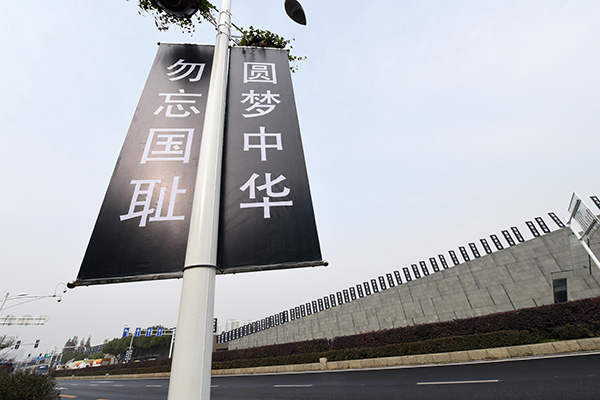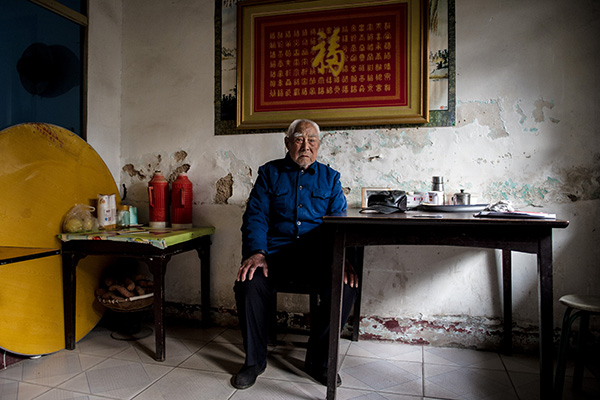
A national-memorial-day-themed placard stands in front of the Nanjing Massacre Memorial Hall in Nanjing, on Dec 11, 2014.[Photo/Xinhua]
NANJING — Nanjing in east China’s Jiangsu province has a history spanning thousands of years stained by invasions and killings, but the Nanjing Massacre, or the Rape of Nanking, eclipsed them all.
The freezing winter of 1937 saw the invading Japanese army kill 300,000 people within six weeks -- an average of one person killed every 12 seconds.
One of the first published accounts of the Nanjing Massacre at that time was a report by Frank Tillman Durdin, a correspondent for The New York Times.
“Wholesale looting, the violation of women, the murder of civilians, the eviction of Chinese from their homes, mass executions of prisoners of war and the impressing of able-bodied men turned Nanking into a city of terror,” he wrote.
Dec 13 will be the first National Memorial Day for Nanjing Massacre Victims. Before the event, Xinhua reporters visited the city to get an insight into what happened on and after Dec 13, 1937.

Liu Zijing, a 102-year-old survivor of Nanjing Massacre sits at home in Hefei, capital of Anhui province, on Dec 11, 2014.[Photo/Xinhua]
The day the Japanese took Nanjing
Chang Zhiqiang, now 86, often reflects on the happy days before the Japanese invasion. “Nanjing was a prosperous city,” he said. “Life was full of fun. There were storytellers, acrobats and magicians.”
His father ran a small grocery store. “He was quiet and reserved,” he said, “my mom was very clever and made all kinds of shoes for children. Everyone liked her.”
As the Japanese army approached Nanjing, refugees from the north flooded in, while locals fled. A telegram sent on October 28, 1937 by Kouki Hirota, then the Japanese foreign minister, suggested that there were more than 530,000 people still left in the city.
Chang recalled how his parents took him, his elder sister and five younger brothers to try and flee the city, but stopped half way to the Yangtze River.
“There were not enough boats,” he said.
So they decided to wait another day, but, unfortunately, the next day was to be the day the city was captured.
In his book, the “Fabrication of the Nanjing Massacre”, Masaaki Tanaka, who was the secretary to a Japanese general in World War II, claimed that on the day the Japanese marched into Nanjing, 120 journalists and photographers did interviews across the city, but none saw any bloodshed.
Chang’s memory of that day, however, is very different.
“They shot from the gate tower. The city became a sea of fire and smoke,” he said.
Several Japanese soldiers entered the house where Chang’s family were hiding. Chang remembered one man fighting with the intruders with nothing but his bare hands, so that others could have time to escape.
But Chang’s parents, concerned about being separated from their children, were caught by the Japanese.
“A devil bayoneted my mom and my sister and brothers hurried to protect her,” recalled the old man, his voice trembling.
“One of my younger brothers was three years old and was scared of anything, even dogs. But at that moment, he bit the devil’ s hand.”
Chang’s youngest brother was still a babe in arms. After his mom was attacked, he fell to the ground. The soldier speared him with his bayonet and tossed him into the air.
When the baby landed, Chang, then only nine years old, lay down with his brother and passed out.
After a while, he opened his eyes. The Japanese soldier had left. He saw his mom breast feeding his youngest brother while collapsed on the floor bleeding, both mother and son were dying.
All his brothers died and his last memory of his father was his lifeless body surrounded by a pool of blood. Only Chang and his sister survived.
It was not long until he heard that dozens of bodies had been buried, like fodder, in a vegetable field. One sight remains etched in his mind, a baby nuzzled up against a woman, milk, tears and snot turned to ice. The two bodies were frozen together and nobody could separate them.
Slaughter and salvage
Today Caoxiexia valley to the northwest of the city is a quiet place. A white monument stands by the road and what was once a reed field is now a water plant.
Zhao Jinhai, guard at the water plant, told Xinhua that people often brought flowers and wreaths for the dead.
Duan Yueping, 82, founder of the Memorial Hall of the Victims of the Nanjing Massacre by Japanese Invaders, spoke of a survivor named Tang Guangpu, who had witnessed the atrocities at Caoxiexia firsthand.
At about 4 a.m. on December 18, 1937, Japanese soldiers began tying up their prisoners, it took them more than 10 hours.
Then they led the bound prisoners to the Yangtze River and executed them with rapid gunfire.
“That day, the river ran red,” Duan said.
Tang hid beneath a corpse until the executers left.
But he was lucky, as sometimes, the Japanese not only shot the prisoners, but also bayoneted and threw them on a burning pyre afterward.
A Japanese veteran soilder Riichi Kurihara (direct translation) said in his postwar account that they burned the corpses to destroy evidence of their barbarism.
“Not all the bodies were completely incinerated, leaving a black mountain of charred corpses,” he said. “It was time-consuming to throw the corpses into the river and that lasted until noon the second day.”
The campaign of murder, rape and looting shocked foreigners in the city, many of whom tried to protect the Chinese people, such as German businessman John Rabe.
His former residence, a two-story black building in downtown Nanjing, concealed and protected more than 600 people.
In the guest book, a visitor from the US, Carol Aschu, said: “We have read Iris Chang’s book, ‘The Rape of Nanking’, and we are glad to find Rabe’s house. This is an important story, both of atrocity and of aid, that no one should forget.”
Another foreigner Wilhelmina Vautrin, then head of the Education Department of the Jinling Women’s Arts and Science College, is remembered by a bust erected several hundred meters away from where the Chinese hid.
“We lived in classrooms, it was so crowded that when you wanted to turn over in the bed, you had to tell the person next to you,” recalled Wu Zhengxi, 90.
However, these “safe zones” were not always so.
Wu’s brother was taken from the college on the claim that he was a infidel.
“Several days later, I found him by a pool, tied to many others,” said the old man, tears in his eyes. “He was a middle school student and I recognized his sports shoes. He was dead.”
Wu’s aunt, who also took refuge in the college, was snatched by the Japanese one day as she tried to sneak home.
“She committed suicide after being raped. I could not tell our family about this.”
Remembrance
Aug 15, 1945, the day the Japanese surrendered, will always be a day Wu remembers.
“I was helping in our restaurant, when I heard a man’s voice from the radio. His voice sounded slow and somber,” he said.
When he looked out into the alley, he saw the Japanese troops kneeling down. The Japanese had lost the war.
In the decades that have passed since these tragedies, the house where Chang’s relatives died is now the site of an apartment building and Wu’s restaurant is now a cell phone store.
But the names of their loved ones are etched, among with 10,000 more, on the 70-meter-long memorial wall in the Memorial Hall of the Victims of the Nanjing Massacre by Japanese Invaders.
More names are to be added, as experts generally agree that the number of victims to be nearer to 300,000.
Sun Zhaiwei, a research fellow with the Jiangsu provincial academy of social sciences, spent more than 30 years reviewing the records of charity organizations and the Kuomintang government. He confirmed that some 246,000 bodies were buried.
But tens of thousands of bodies were thrown into the Yangtze River, never to be found.
When asked about the denial of the massacre by right-wing nationalists in Japan, both Chang and Wu became emotional.
“They are liars,” Chang said, before continuing with flurry of vitriol, while Wu asked: “Are they even human?”
There are only around 100 survivors of the massacre still alive.
To ensure lessons will be learned and the truth heard, both Chang and Wu are penning memoirs.
“I want to let more people know about what really happened 77 years ago, which every generation should remember,” Chang said.
Wu’s only wish is: “To live to hear the Japanese sincerely apologize.”
